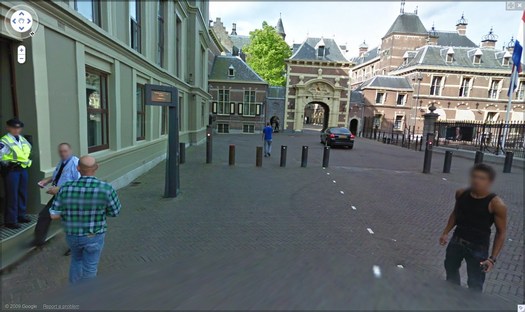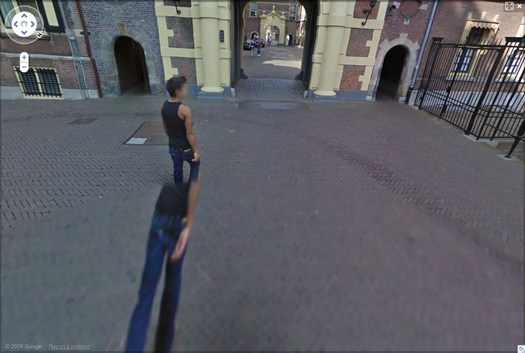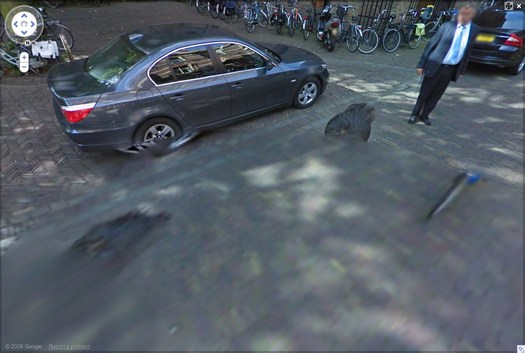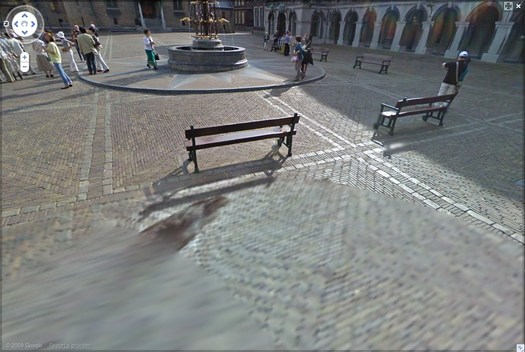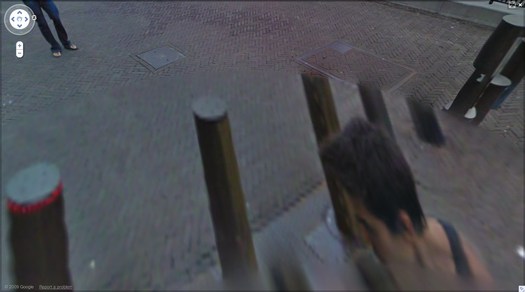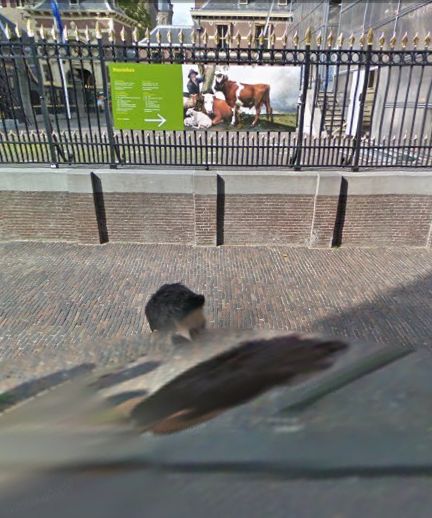
Last February, I realized that the subject of this awesome, distorted Google Street View portrait was not just a random pedestrian. Hundreds of thousands, if not millions, of people around the world have been photographed once by Google's roving, robotic cameras. This guy appears at least 63 times.
He did this by walking alongside the Google Street View Trike, which made its first, unannounced foray into continental Europe in the Summer of 2009, scanning the Binnenhof, the courtyard complex which houses the Dutch parliament.
Sometimes he walked slightly ahead, and his presence was treated as part of the target landscape. But most of the time, he was close enough to the cameras that his looming form was considered an obstruction. Then the algorithms used to stitch each panorama together would try to erase him, leaving nothing but a disembodied wig or a man-sized lozenge of cobblestones.
Even when it's minimal, this compositing can be sufficient to reveal the panos' making of: for example, the fragmented bike tire at the bottom of this nearly perfect Street View composition indicates that cobblestone demilune was taken several seconds before the rest of the image.
Walking Man's floating head, the guy with the tie, the bike, the Google Maps marker, the compass, the light, the architecture, the politics, I just love this image. It makes me want to print it large and hang it on a wall.
 Walking Man's persistent present brings to Street View something that it lacked, probably by design: a sense of elapsed time. Even though the images are shot over the course of years, to the user, Street View always appears frozen into a single, unspecified moment. Fly through it, and the passing of time is yours, not the blurred out subjects'.
Walking Man's persistent present brings to Street View something that it lacked, probably by design: a sense of elapsed time. Even though the images are shot over the course of years, to the user, Street View always appears frozen into a single, unspecified moment. Fly through it, and the passing of time is yours, not the blurred out subjects'.
[This atemporality partly explains the thrill of finding scenes of actual action in Street View, such as birds captured in flight, the commission of crimes, Norwegian goofballs in scuba gear, or the kind of classic stolen moments in Michael Wolf's Street View street photography (left).]
But the Binnenhof complex itself turns out to be uniquely revealing of Google's photography practice. After passing through security and entering the gate [above], the Google Trike made a single loop around the edge of the courtyard in front of the Ridderzaal, or Knight's Hall, where the Queen makes her annual address to Parliament.
Then it doubled back through the security gate before turning at the Mauritshuis, the Royal Gallery [top], and circling the adjacent lake.
Which means that the two fractured images of Walking Man in the pano above are taken, not just several seconds apart, but several minutes: his legs are from the beginning of the tour, his head from the end. The
By the time I printed some artist books containing the full set of 63 Walking Man portraits, I'd figured out that the Google Trike usually has a wingman. Which means the guy was almost certainly an imaging contractor or a Google employee, a job my Dutch neighbor called, "the Google Guide."
So rather than a civilian co-optation of Street View, what we're seeing is a serial portrait of the men behind the cameras. Or at least the men pedaling away under the cameras. Which is where my idea for a Google Trike-based art project originated. Which I'll write about in a little while.
Previously, April 2010: Walking Man: The Book
Google Trike has a posse

